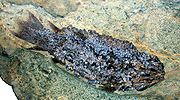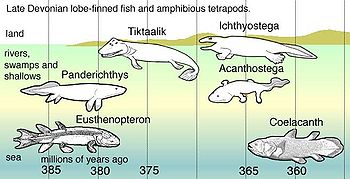
Eusthenopteron
Encyclopedia
Eusthenopteron is a genus
of prehistoric lobe-finned fish which has attained an iconic status from its close relationships to tetrapod
s. Early depictions of this animal show it emerging onto land, however paleontologists now widely agree that it was a strictly aquatic animal. The genus Eusthenopteron is known from several species that lived during the Late Devonian period, about 385 million years ago. Eusthenopteron was first described by J. F. Whiteaves in 1881, as part of a large collection of fishes from Miguasha, Quebec. Some 2,000 Eusthenopteron specimens have been collected from Miguasha, one of which was the object of intensely detailed study and several papers from the 1940s to the 1990s by paleoichthyologist Erik Jarvik
.
 Anatomically, Eusthenopteron shares many unique features in common with the earliest known tetrapod
Anatomically, Eusthenopteron shares many unique features in common with the earliest known tetrapod
s. It shares a similar pattern of skull rooting bones with forms such as Ichthyostega
and Acanthostega
. Eusthenopteron, like other tetrapodomorph fishes
, had internal nostrils, (or a choana
) which are found only in land animals and sarcopterygians
. It also had labyrinthodont teeth, characterized by infolded enamel
, which characterizes all of the earliest known tetrapods as well. Like other basal sarcopterygians, Eusthenopteron possessed a two-part cranium, which hinged at mid-length along an intracranial joint. Eusthenopterons notoriety comes from the pattern of its fin endoskeleton
, which bears a distinct humerus, ulna, and radius (in the fore-fin) and femur, tibia, and fibula (in the pelvic fin). This is the characteristic pattern seen in tetrapods. It is now known to be a general character of fossil sarcopterygian fins.
 Eusthenopteron differs significantly from later Carboniferous
Eusthenopteron differs significantly from later Carboniferous
tetrapods in the apparent absence of a recognized larval stage and a definitive metamorphosis. In even the smallest known specimen of Eusthenopteron foordi (at 29 mm), the lepidotrichia cover all of the fins, which does not happen until after metamorphosis in genera like Polyodon. This might indicate that Eusthenopteron developed directly, with the hatchling already attaining the general body form of the adult (Cote et al., 2002). So, Jarvik was perhaps not correct as he proposed (1980) Palaeospondylus gunni might have been the larva (tadpole-like) of Eusthenopteron.
Genus
In biology, a genus is a low-level taxonomic rank used in the biological classification of living and fossil organisms, which is an example of definition by genus and differentia...
of prehistoric lobe-finned fish which has attained an iconic status from its close relationships to tetrapod
Tetrapod
Tetrapods are vertebrate animals having four limbs. Amphibians, reptiles, birds and mammals are all tetrapods; even snakes and other limbless reptiles and amphibians are tetrapods by descent. The earliest tetrapods evolved from the lobe-finned fishes in the Devonian...
s. Early depictions of this animal show it emerging onto land, however paleontologists now widely agree that it was a strictly aquatic animal. The genus Eusthenopteron is known from several species that lived during the Late Devonian period, about 385 million years ago. Eusthenopteron was first described by J. F. Whiteaves in 1881, as part of a large collection of fishes from Miguasha, Quebec. Some 2,000 Eusthenopteron specimens have been collected from Miguasha, one of which was the object of intensely detailed study and several papers from the 1940s to the 1990s by paleoichthyologist Erik Jarvik
Erik Jarvik
Anders Erik Vilhelm Jarvik was a Swedish palaeozoologist who worked extensively on the sarcopterygian fish Eusthenopteron...
.
Description

Tetrapod
Tetrapods are vertebrate animals having four limbs. Amphibians, reptiles, birds and mammals are all tetrapods; even snakes and other limbless reptiles and amphibians are tetrapods by descent. The earliest tetrapods evolved from the lobe-finned fishes in the Devonian...
s. It shares a similar pattern of skull rooting bones with forms such as Ichthyostega
Ichthyostega
Ichthyostega is an early tetrapod genus that lived at the end of the Upper Devonian period . It was a labyrinthodont, one of the first fossil record of tetrapods. Ichthyostega possessed lungs and limbs that helped it navigate through shallow water in swamps...
and Acanthostega
Acanthostega
Acanthostega is an extinct labyrinthodont genus, among the first vertebrate animals to have recognizable limbs. It appeared in the Upper Devonian about 365 million years ago, and was anatomically intermediate between lobe-finned fishes and the first tetrapods fully capable of coming onto...
. Eusthenopteron, like other tetrapodomorph fishes
Tetrapodomorpha
Tetrapodomorpha is a clade of vertebrates, consisting of tetrapods and their closest sarcopterygian relatives that are more closely related to living tetrapods than to living lungfish...
, had internal nostrils, (or a choana
Choana
Choana is the posterior nasal aperture.The choanae are separated by the vomer.- Boundaries :It is the opening between the nasal cavity and the nasopharynx....
) which are found only in land animals and sarcopterygians
Sarcopterygii
The Sarcopterygii or lobe-finned fishes – sometimes considered synonymous with Crossopterygii constitute a clade of the bony fishes, though a strict classification would include the terrestrial vertebrates...
. It also had labyrinthodont teeth, characterized by infolded enamel
Tooth enamel
Tooth enamel, along with dentin, cementum, and dental pulp is one of the four major tissues that make up the tooth in vertebrates. It is the hardest and most highly mineralized substance in the human body. Tooth enamel is also found in the dermal denticles of sharks...
, which characterizes all of the earliest known tetrapods as well. Like other basal sarcopterygians, Eusthenopteron possessed a two-part cranium, which hinged at mid-length along an intracranial joint. Eusthenopterons notoriety comes from the pattern of its fin endoskeleton
Endoskeleton
An endoskeleton is an internal support structure of an animal, composed of mineralized tissue. Endoskeleton develops within the skin or in the deeper body tissues. The vertebrate is basically an endoskeleton made up of two types of tissues . During early embryonic development the endoskeleton is...
, which bears a distinct humerus, ulna, and radius (in the fore-fin) and femur, tibia, and fibula (in the pelvic fin). This is the characteristic pattern seen in tetrapods. It is now known to be a general character of fossil sarcopterygian fins.

Carboniferous
The Carboniferous is a geologic period and system that extends from the end of the Devonian Period, about 359.2 ± 2.5 Mya , to the beginning of the Permian Period, about 299.0 ± 0.8 Mya . The name is derived from the Latin word for coal, carbo. Carboniferous means "coal-bearing"...
tetrapods in the apparent absence of a recognized larval stage and a definitive metamorphosis. In even the smallest known specimen of Eusthenopteron foordi (at 29 mm), the lepidotrichia cover all of the fins, which does not happen until after metamorphosis in genera like Polyodon. This might indicate that Eusthenopteron developed directly, with the hatchling already attaining the general body form of the adult (Cote et al., 2002). So, Jarvik was perhaps not correct as he proposed (1980) Palaeospondylus gunni might have been the larva (tadpole-like) of Eusthenopteron.
In popular culture
- Eusthenopteron was featured in the second episode of Animal ArmageddonAnimal ArmageddonAnimal Armageddon is an American paleontology-based documentary television miniseries that originally aired from to on Animal Planet. All the prehistoric scenes are created 100% in Lightwave...
. - Eusthenopteron has also been widely featured in textbooks as a 'missing link' between fish and tetrapods.
- Eusthenopteron were also featured within the large amount of other ancient fish in the movie Ponyo.
See also
- TiktaalikTiktaalikTiktaalik is a genus of extinct sarcopterygian from the late Devonian period, with many features akin to those of tetrapods . It is an example from several lines of ancient sarcopterygian "fish" developing adaptations to the oxygen-poor shallow-water habitats of its time, which led to the...
, an even more tetrapod-like sarcopterygian. - GogonasusGogonasusGogonasus was a lobe-finned fish known from 3-dimensionally preserved 380 million-year-old fossils found from the Gogo Formation in Western Australia. It lived in the late Devonian period, on what was once a 1400 kilometre coral reef off the Kimberley coast surrounding the north-west of Australia...
External references
- http://www.palaeos.com/Vertebrates/Units/140Sarcopterygii/140.860.html

